
Colour composite image of the Subaru XMM-Newton deep survey field. In the right panel, the red galaxy at the centre of the image is the most distant galaxy, SXDF-NB1006-2, according to the astronomers. Image by NAOJ
Using the Subaru and Keck optical/infrared telescopes on Hawaii’s Mauna Kea, a 4,200 metre-high summit which houses the world’s largest observatory for optical, infrared and submillimeter astronomy, a team of Japanese astronomers claim in a recently published paper that they’ve discovered the earliest galaxy found thus far in the known Universe – it is 12.91 billion years old or 12.91 billion light years away.
A light-year is the distance that light travels in a year, about 6 trillion miles – don’t multiply this by the estimated distance from above; it might give you headaches.
At the beginning of the year, scientists at Hubble discovered, what they claim was, the oldest galaxy cluster ever found, at 13.1 billion years, while last year a California team using Hubble said they saw a galaxy from 13.2 billion light-years ago. However, neither of the two teams managed to prove their calculations through other methods.
The Japanese claim for the oldest galaxy found thus far, dubbed “SXDF-NB1006-2”, is more “watertight,” according to other corresponding scientists, since it uses methods that everyone can agree on. Current theory holds that the universe was born of an explosion, called the Big Bang, about 13.7 billion years ago. Using top-notch infrared and optical telescopes, astronomers peer right through the early days of the Universe.
The astronomers are also claiming their research has verified that the proportion of neutral hydrogen gas in the 750m-year-old early universe was higher than it is today. Thus, some 200 to 500 million years after the Big Bang, the dense parts of neutral hydrogen clouds contracted under their own gravity, forming the first stars and galaxies.
“These findings help us to understand the nature of the early universe during the ‘cosmic dawn’, when the light of ancient celestial objects and structures appeared from obscurity,” indicated an NAOJ statement.
“The radiation from this first generation of stars started to heat and reionise the hydrogen in nearby space, eventually leading to the reionisation of the entire universe. This was the era of ‘cosmic reionisation,'” said the NAOJ.
The findings will be published in the journal the Astrophysical Journal.
via Silicon Republic









